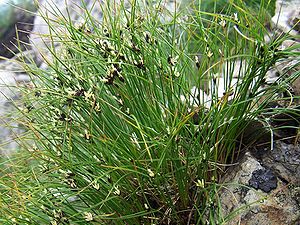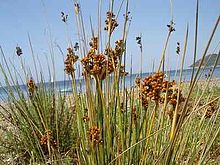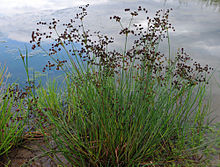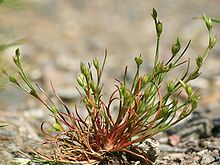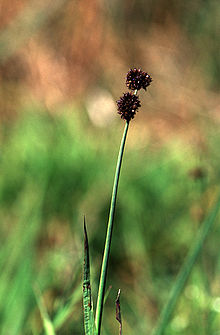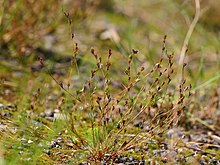
Compressed rush ( Juncus compressus )
-
Juncus acuminatus Michx., Fl. Bor.-Amer. 1: 192 (1803)
-
Pointed rush ( Juncus acutiflorus ) Ehrh. ex Hoffm., Germany. Fl .: 125 (1791). With two subspecies.
-
Stinging rush ( Juncus acutus ) L., Sp. Pl .: 325 (1753). With two subspecies.
-
Juncus aemulans Liebm., Vidensk. Meddel. Naturhist. Forums. Kjøbenhavn 2:38 (1850)
-
Juncus alatus Franch. & Sav., Enum. Pl. Jap. 2: 98 (1879)
-
Juncus alexandri LASJohnson in MRBanks & al. (ed.) Aspects Tasmanian Bot .: 37 (1991). With two subspecies.
-
Juncus allioides Franch., Nouv. Arch. Mus. Hist. Nat., II, 10:99 (1887)
-
Juncus alpigenus K. Koch, Linnaea 21: 627 (1848)
-
Alpine bulrush ( Juncus alpinoarticulatus ) Chaix, Pl.Vapinc .: 74 (1785). With six subspecies.
-
Juncus amabilis Edgar, New Zealand J. Bot. 2: 186 (1964)
-
Juncus amplifolius A. Camus, Notul. Syst. (Paris) 1: 281 (1910)
-
Juncus amuricus (Maxim.) VIKrecz. & Gontsch. in VLKomarov (ed.), Fl. URSS 3: 623 (1935)
-
Juncus anatolicus Snogerup, Bot. Not. 131: 194 (1978)
-
Double-edged bulrush ( Juncus anceps ) Laharpe, Essai Monogr. Jonc .: 38 (1825)
-
Juncus andersonii Buchenau in HGAEngler, Pflanzenr., IV, 36: 202 (1906)
-
Juncus antarcticus Hook.f., Fl. Antarct. 1: 79 (1844)
-
Juncus anthelatus (Wiegand) RE Brooks & Whittem., Novon 9:11 (1999)
-
Arctic bulrush ( Juncus arcticus ) Willd., Sp. Pl. 2: 206 (1799). With three subspecies.
-
Juncus aridicola LASJohnson in JMBlack, Fl. S. Austral., Ed. 3, 1: 322 (1978)
-
Link rush ( Juncus articulatus ) L., Sp. Pl .: 327 (1753). With two subspecies.
-
Juncus astreptus LASJohnson in MRBanks & al. (ed.) Aspects Tasmanian Bot .: 37 (1991)
-
Black bulrush ( Juncus atratus ) croquet., Fl. Siles. 1: 562 (1787)
-
Juncus australis Hook.f., Fl. Tasman. 2: 66 (1858)
-
Juncus baekdusanensis M. Kim , Korean J. Pl. Taxon. 44: 239 (2014).
-
Baltic bulrush ( Juncus balticus ) Willd., Mag. Latest discovery. Total natural Ges. Naturf. Friends of Berlin 3: 298 (1809). With seven subspecies.
-
Juncus bassianus LASJohnson in MRBanks & al. (ed.) Aspects Tasmanian Bot .: 37 (1991)
-
Juncus batrachium Veldkamp, Blumea 59: 142 (2014).
-
Juncus benghalensis Kunth, Enum. Pl. 3: 360 (1841)
-
Juncus beringensis Buchenau, Bot. Jahrb. Syst. 12: 226 (1890)
-
Juncus biflorus Elliott, Sketch Bot. S. Carolina 1: 407 (1817).
-
Two-flowered rush ( Juncus biglumis ) L., Sp.Pl .: 328 (1753)
-
Juncus biglumoides H. Hara , J. Jap. Bot. 49: 201 (1974)
-
Juncus bolanderi Engelm., Trans. Acad. Sci. St. Louis 2: 470 (1868)
-
Juncus brachycarpus Engelm. in A. Gray, Manual, ed. 5, 542 (1867)
-
Juncus brachycephalus (Engelm.) Buchenau, Bot. Jahrb. Syst. 12: 268 (1890)
-
Juncus brachyphyllus Wiegand, Bull. Torrey Bot. Club 27: 519 (1900)
-
Juncus brachyspathus Maxim., Mém. Acad. Imp. Sci. Saint-Pétersbourg, Sér. 6, Sci. Math., Seconde Pt. Sci. Nat. 9: 293 (1859)
-
Juncus brachystigma Sam. in HREHandel-Mazzetti, Symb. Sin. 7: 1236 (1936)
-
Juncus brasiliensis Breistr., Bull. Soc. Sci. Isère, VI, 1: 609 (1947)
-
Juncus brevibracteus LASJohnson, Telopea 5: 309 (1993)
-
Juncus brevicaudatus (Engelm.) Fernald, Rhodora 6:35 (1904)
-
Juncus breviculmis Balslev, Brittonia 35: 303 (1983)
-
Juncus breweri Engelm., Trans. Acad. Sci. St. Louis 2: 440 (1866)
-
Juncus bryoides FJ Herm., Leafl. W. Bot. 5: 117 (1948)
-
Juncus bryophilus WWSm., Edinburgh J. Bot. 51: 137 (1994)
-
Toad bulrush ( Juncus bufonius ) L., Sp.Pl .: 328 (1753)
-
Bulbous rush ( Juncus bulbosus ) L., Sp.Pl .: 327 (1753)
-
Juncus burkartii Barros, Darwiniana 10:431 (1953)
-
Juncus caesariensis Coville, Mem.Torrey Bot. Club 5: 106 (1894)
-
Juncus caespiticius E. Mey. in JGCLehmann, Pl. Price. 2: 47 (1846)
-
Canadian bulrush ( Juncus canadensis ) J. Gay ex Laharpe, Essai Monogr. Jonc .: 46 (1825)
-
Juncus capensis Thunb., Prodr. Pl. Cap. 1: 66 (1794)
-
Juncus capillaceus Lam., Encycl. 3: 266 (1789)
-
Juncus capillaris FJ Herm., Leafl. W. Bot. 5: 116 (1948)
-
Head bulrush ( Juncus capitatus ) Weigel, Observ. Bot .: 28 (1772)
-
Maroon bulrush ( Juncus castaneus ) Sm., Fl. Brit. 1: 383 (1800). With three subspecies.
-
Juncus cephalostigma Sam. in HREHandel-Mazzetti, Symb. Sin. 7: 1233 (1936)
-
Juncus cephalotes Thunb., Prodr. Pl.Cap .: 66 (1794)
-
Juncus chiapasensis Balslev, Ann. Missouri Bot. Gard. 75: 379 (1988)
-
Juncus chlorocephalus Engelm., Trans. Acad. Sci. St. Louis 2: 485 (1868)
-
Juncus chrysocarpus Buchenau, Bot. Jahrb. Syst. 6: 201 (1885)
-
Juncus clarkei Buchenau, Bot. Jahrb. Syst. 6: 210 (1885)
-
Compressed rush ( Juncus compressus ) Jacq., Enum. Stirp. Vindob .: 60, 235 (1762)
-
Juncus concinnus D. Don, Prodr. Fl. Nepal .: 44 (1825)
-
Juncus concolor Sam. in HREHandel-Mazzetti, Symb. Sin. 7: 1232 (1936)
-
Juncus confusus Coville, Proc. Biol. Soc. Wash. 10: 127 (1896)
-
Bulrush ( Juncus conglomeratus ) L., Sp.Pl .: 326 (1753)
-
Juncus continuus LASJohnson in JMBlack, Fl. S. Austral., Ed. 3, 1: 325 (1978)
-
Juncus cooperi Engelm., Trans. Acad. Sci. St. Louis 2: 590 (1868)
-
Juncus cordobensis Barros, Lilloa 28:279 (1957)
-
Juncus coriaceus Mack., Bull. Torrey Bot. Club 56:28 (1929)
-
Juncus covillei Piper, Contr. US Natl. Herb. 11: 182 (1906). With two varieties.
-
Juncus crassistylus A. Camus, Notul. Syst. (Paris) 1: 278 (1910)
-
Juncus curtisiae LASJohnson in MRBanks & al. (ed.) Aspects Tasmanian Bot .: 44 (1991)
-
Juncus curvatus Buchenau in HGAEngler (ed.), Pflanzenr., IV, 36: 128 (1906)
-
Juncus cyperoides Laharpe, Essai Monogr. Jonc .: 57 (1825)
-
Juncus debilis A. Gray, Manual: 506 (1848)
-
Juncus decipiens (Buchenau) Nakai, Veg. Kamikochi: 35 (1928). With three subspecies.
-
Juncus densiflorus Kunth in FWHvon Humboldt, AJABonpland & CSKunth, Nov. Gen. Sp. 1: 238 (1816)
-
Juncus deosaicus Noltie, Edinburgh J. Bot. 55: 41 (1998)
-
Juncus diastrophanthus Buchenau, Bot. Jahrb. Syst. 12: 309 (1890)
-
Juncus dichotomus Elliott, Sketch Bot.S. Carolina 1: 406 (1817)
-
Juncus diemii Barros, Darwiniana 10:65 (1952)
-
Juncus diffusissimus Buckley, Proc. Acad. Nat. Sci. Philadelphia 14: 9 (1862)
-
Juncus digitatus CW Witham & Zika, J. Bot. Res. Inst. Texas 2: 775 (2008).
-
Juncus distegus Edgar, New Zealand J. Bot. 2: 183 (1964)
-
Juncus dolichanthus LAS Johnson, Telopea 5: 310 (1993)
-
Juncus dongchuanensis KFWu, Acta Phytotax. Sin. 32: 457 (1994)
-
Juncus dregeanus Kunth, Enum. Pl. 3: 344 (1841). With two subspecies.
-
Juncus drummondii E. Mey. in CF from Ledebour, Fl. Horse. 4: 235 (1853)
-
Juncus dubius Engelm., Trans. Acad. Sci. St. Louis 2: 459 (1868)
-
Dudley's Bulrush ( Juncus dudleyi ) Wiegand, Bull. Torrey Bot. Club 27: 524 (1900)
-
Juncus dulongjiongensis Novikov, Byull. Moskovsk. Obshch. Isp. Prir., Otd. Biol. 103 (4): 69 (1998)
-
Juncus durus LASJohnson & KLWilson, Telopea 9: 380 (2001)
-
Juncus duthiei (CBClarke) Noltie, Edinburgh J. Bot. 51: 134 (1994)
-
Juncus ebracteatus E. Mey., Syn. Junc .: 28 (1822)
-
Juncus echinocephalus Balslev, Fl. Ecuador 11:37 (1979)
-
Juncus ecuadoriensis Balslev, Fl. Ecuador 11:36 (1979)
-
Juncus edgariae LASJohnson & KLWilson, Telopea 9: 399 (2001)
-
Flutter rush ( Juncus effusus ) L., Sp. Pl .: 326 (1753). With five subspecies.
-
Juncus elbrusicus Galushko, Novosti Sist. Vyssh. Rest. 6: 212 (1970)
-
Juncus elliottii Chapm., Fl. South. US: 494 (1860)
-
Juncus emmanuelis A. Fern . & JGGarcía, Bol. Soc. Bread., II, 21: 6 (1947)
-
Juncus engleri Buchenau in HGAEngler, Pflanzenr., IV, 36: 248 (1906)
-
Sword-leaved rush ( Juncus ensifolius ) Wikstr., Kongl. Vetensk. Acad. Handl. 2: 1 (1824)
-
Juncus equisetinus Proskur., Byull. Moskovsk. Obshch. Isp. Prir., Otd. Biol. 80 (2): 117 (1975)
-
Juncus ernesti-barrosi Barros, Darwiniana 10:433 (1953)
-
Juncus exiguus (Fernald & Wiegand) Lint ex Snogerup & PFZika, Preslia 74: 260 (2002)
-
Juncus exsertus Buchenau, Monogr. Junc. Cap: 435 (1875)
-
Juncus falcatus E. Mey., Syn. Luzul .: 34 (1823). With two subspecies.
-
Juncus fascinatus (MCJohnst.) WMKnapp, Phytotaxa 174: 256 (2014).
-
Juncus fauriei Lév. & Vaniot, Bull. Soc. Bot. France 51: 292 (1904)
-
Juncus fauriensis Buchenau, notepad. Royal Bot. Garden Berlin 3: 127 (1901). With two subspecies.
-
Juncus fernandez-carvajaliae Romero Zarco & Arán, Nordic J. Bot. 31: 190 (2013).
-
Juncus filicaulis Buchenau, Proc. Linn. Soc. New South Wales 28: 913 (1904)
-
Filiform rush ( Juncus filiformis ) L., Sp.Pl .: 326 (1753)
-
Juncus filipendulus Buckley, Proc. Acad. Nat. Sci. Philadelphia 1862: 8 (1862)
-
Juncus fimbristyloides Noltie, Edinburgh J. Bot. 55: 39 (1998)
-
Juncus firmus LAS Johnson, Telopea 5: 311 (1993)
-
Juncus flavidus LASJohnson in JMBlack, Fl. S. Austral., Ed. 3, 1: 325 (1978)
-
Juncus fockei Buchenau, Bot. Jahrb. Syst. 12: 359 (1890)
-
Juncus foliosus Desf., Fl. Atlant. 1: 315 (1798)
-
Juncus fominii Zoz, Sbirn. Pric. Pamj. Akad. OB Fomina: 51 (1938)
-
Juncus fontanesii J. Gay ex Laharpe, Essai Monogr. Jonc .: 42 (1825). With four subspecies.
-
Juncus fugongensis SYBao, in Fl. Yunnanica 15: 804 (2003)
-
Juncus ganeshii Miyam. & H. Ohba, J. Jap. Bot. 70: 245 (1995)
-
Juncus georgianus Coville, Bull. Torrey Bot. Club 22:44 (1895)
-
Bodden bulrush ( Juncus gerardii ) Loisel., J. Bot. (Desvaux) 2: 284 (1809). With three subspecies.
-
Juncus giganteus Sam., Acta Hort. Gothob. 3:70 (1927)
-
Juncus glaucoturgidus Noltie, Edinburgh J. Bot. 51: 132 (1994)
-
Juncus gonggae Miyam. & H. Ohba, J. Jap. Bot. 72: 162 (1997)
-
Juncus gracilicaulis A. Camus, Notul. Syst. (Paris) 1: 279 (1910)
-
Juncus gracillimus (Buchenau) VIKrecz. & Gontsch. in VLKomarov (ed.), Fl. URSS 3: 528 (1935)
-
Juncus greenei Oakes & Tuck., Amer. J. Sci. Arts 45: 37 (1843)
-
Juncus gregiflorus LASJohnson, Contr. New South Wales Natl. Herb. 3: 243 (1963)
-
Juncus grisebachii Buchenau, Dep. Naturwiss. Clubs Bremen 3: 295 (1873)
-
Juncus guadeloupensis Buchenau & Urb., Symb. Antill. 1: 496 (1900)
-
Juncus gubanovii Novikov, Byull. Moskovsk. Obshch. Isp. Prir., Otd. Biol. 80 (3): 130 (1975)
-
Juncus gymnocarpus Coville, Mem.Torrey Bot. Club 17: 106 (1894)
-
Juncus haenkei E. Mey., Syn. Junc .: 10 (1822)
-
Juncus hallii Engelm., Trans. Acad. Sci. St. Louis 2: 433 (1866)
-
Juncus harae Miyam. & H. Ohba, J. Jap. Bot. 68: 27 (1993)
-
Juncus heldreichianus T.Marsson ex Parl., Fl. Ital. 2: 315 (1852). With two subspecies.
-
Juncus hemiendytus FJHerm., Leafl. W. Bot. 5: 118 (1948). With two varieties.
-
Juncus heptopotamicus VIKrecz. & Gontsch. in VLKomarov (ed.), Fl. URSS 3: 628 (1935)
-
Juncus hesperius (Piper) Lint, Preslia 74: 263 (2002)
-
Juncus heterophyllus Dufour, Ann. Sci. Nat. (Paris) 5:88 (1825)
-
Juncus himalensis Klotzsch, Bot. Result. Journey Waldemar: 60 (1862)
-
Juncus holoschoenus R.Br., Prodr. Fl. Nov. Holl. 1: 259 (1810)
-
Juncus homalocaulis F. Muell. ex Benth., Fl. Austral. 7: 128 (1878)
-
Juncus howellii FJHerm., Leafl. W. Bot. 5: 182 (1949)
-
Juncus hybridus bread., Fl. Lusit. 1: 513 (1804)
-
Juncus hydrophilus Noltie, Edinburgh J. Bot. 51: 138 (1994)
-
Juncus imbricatus Laharpe, Essai Monogr. Jonc .: 61 (1825)
-
Blue-green rush ( Juncus inflexus ) L., Sp. Pl .: 326 (1753). With two subspecies.
-
Juncus ingens NAWakef., Victoria Naturalist 73: 211 (1957)
-
Juncus interior Wiegand, Bull. Torrey Bot. Club 27: 516 (1900)
-
Chamois rush ( Juncus jacquinii ) L., Mant. Pl. 1: 63 (1767)
-
Juncus jaxarticus VIKrecz. & Gontsch. in VLKomarov (ed.), Fl. URSS 3: 628 (1935)
-
Juncus jinpingensis SYBao, in Fl. Yunnanica 15: 804 (2003)
-
Juncus kelloggii Engelm., Trans. Acad. Sci. St. Louis 2: 494 (1868)
-
Juncus khasiensis Buchenau, Bot. Jahrb. Syst. 12: 407 (1890)
-
Juncus kingii Rendle, J. Bot. 44: 45 (1906)
-
Juncus kleinii Barros, Sellowia 14:27 (1962)
-
Juncus krameri Franch. & Sav., Enum. Pl. Jap. 2: 99 (1879)
-
Juncus kraussii Hochst., Flora 28: 342 (1845). With three subspecies.
-
Juncus kuohii MJJung, Phytotaxa 81: 49 (2013).
-
Juncus laccatus PFZika, Preslia 74: 261 (2002)
-
Juncus laeviusculus LASJohnson in MRBanks & al. (ed.) Aspects Tasmanian Bot .: 38 (1991). With two subspecies.
-
Juncus lancangensis YYQian, Bull. Bot. Res., Harbin 21: 3 (2001).
-
Juncus leiospermus FJHerm., Leafl. W. Bot. 5: 113 (1948). With two varieties.
-
Juncus leptospermus Buchenau, Bot. Jahrb. Syst. 6: 203 (1885)
-
Juncus lesueurii Bol., Proc. Calif. Acad. Sci. 2: 179 (1863)
-
Juncus leucanthus Royle ex D. Don, Proc. Linn. Soc. London 1:10 (1840)
-
Juncus leucomelas Royle ex D.Don, Proc. Linn. Soc. London 1:10 (1840)
-
Juncus liebmannii JFMacbr., Field Mus. Nat. Hist., Bot. Ser. 11 (1): 9 (1931). With three varieties.
-
Juncus littoralis CAMey., Dir. Pfl. Casp. Sea .: 34 (1831)
-
Juncus llanquihuensis Barros, Darwiniana 10:425 (1953)
-
Juncus lomatophyllus Spreng., New Discovery. Plant k. 2: 108 (1821)
-
Juncus longiflorus (A. Camus) Noltie, Edinburgh J. Bot. 51: 134 (1994)
-
Juncus longii Fernald, Rhodora 39: 397 (1937).
-
Juncus longirostris Kuvaev, Bot. Zhurn. (Moscow & Leningrad) 57: 815 (1972)
-
Juncus longistamineus A. Camus, Notul. Syst. (Paris) 1: 277 (1910)
-
Juncus longistylis Torr. in WHEmory, Rep. US Mex. Bound .: 223 (1859)
-
Juncus luciensis Ertter, Mem. New York Bot. Gard. 39:58 (1986)
-
Juncus luzuliformis Franch., Nouv. Arch. Mus. Hist. Nat., II, 10:99 (1887)
-
Juncus macrandrus Coville, Ill. Fl. Pacific States 1: 367 (1923)
-
Juncus macrantherus VIKrecz. & Gontsch. in VLKomarov (ed.), Fl. URSS 3: 626 (1935)
-
Juncus macrophyllus Coville, Univ. Calif. Publ. Bot. 1:65 (1902)
-
Juncus marginatus Rostk., De Junco: 38 (1801)
-
Sea-beach bulrush ( Juncus maritimus ) Lam., Encycl. 3: 264 (1789)
-
Juncus maroccanus Kirschner, Preslia 76: 372 (2004)
-
Juncus maximowiczii Buchenau, Bot. Jahrb. Syst. 12: 394 (1890)
-
Juncus megacephalus MACurtis, Boston J. Nat. Hist. 1: 132 (1835)
-
Juncus megalophyllus SYBao, in Fl. Yunnanica 15: 804 (2003)
-
Juncus meianthus LASJohnson ex KLWilson, Taxon 50: 1112 (2001)
-
Juncus membranaceus Royle, Proc. Linn. Soc. London 1:10 (1840)
-
Juncus mertensianus Bong., Mém. Acad. Imp. Sci. St.-Pétersbourg, Sér. 6, Sci. Math. 6 (2): 167 (1833)
-
Juncus micranthus Schrad. ex E. Mey., Syn. Luzul .: 31 (1823)
-
Juncus microcephalus Kunth in FWHvon Humboldt, AJABonpland & CSKunth, Nov. Gen. Sp. 1: 237 (1816)
-
Juncus milashanensis AMLu & ZYZhang, Acta Phytotax. Sin. 17: 127 (1979)
-
Juncus militaris Bigelow, Fl. Boston., Ed. 2: 139 (1824)
-
Juncus minimus Buchenau, Bot. Zeitung (Berlin) 25: 145 (1867)
-
Smallest bulrush ( Juncus minutulus ) (Albert & Jahand.) Prain, Index Kew., Suppl. 5: 143 (1921)
-
Juncus modicus NEBr., J. Linn. Soc., Bot. 36: 165 (1903)
-
Juncus mollis LASJohnson, Telopea 5: 311 (1993)
-
Single-flowered rush ( Juncus monanthos ) Jacq., Enum. Stirp. Vindob .: 61, 236 (1762) (Syn .: Oreojuncus monanthos (Jacq.) Záv.Drábk. & Kirschner)
-
Juncus mustangensis Miyam. & H. Ohba, J. Jap. Bot. 78: 154 (2003)
-
Juncus nepalicus Miyam. & H. Ohba, J. Jap. Bot. 68:28 (1993)
-
Juncus nevadensis S Watson, Proc. Amer. Acad. Arts 14: 303 (1879)
-
Juncus nodatus Coville in NLBritton & A.Brown, Ill. Fl. NUS, ed. 2, 1: 482 (1913)
-
Juncus nodosus L., Sp.Pl., Ed. 2, 1: 466 (1762)
-
Juncus novae-zelandiae Hook.f., Fl. Nov.-Zel. 1: 264 (1853)
-
Juncus nupela Veldkamp, Blumea 23: 415 (1977)
-
Juncus obliquus Adamson, JS African Bot. 3: 165 (1937)
-
Juncus occidentalis Wiegand, Bull. Torrey Bot. Club 27: 523 (1900)
-
Juncus ochraceus Buchenau, Dep. Naturwiss. Clubs Bremen 3: 292 (1873)
-
Juncus ochrocoleus LASJohnson, Telopea 5: 312 (1993)
-
Juncus orchonicus Novikov, Byull. Moskovsk. Obshch. Isp. Prir., Otd. Biol. 90 (5): 110 (1985)
-
Juncus orthophyllus Coville, Contr. US Natl. Herb. 4: 207 (1893)
-
Juncus oxycarpus E. Mey. ex Kunth, Enum. Pl. 3: 336 (1841)
-
Juncus oxymeris Engelm., Trans. Acad. Sci. St. Louis 2: 483 (1868)
-
Juncus pallescens Lam., Encycl. 3: 268 (1789)
-
Juncus pallidus R.Br., Prodr. Fl. Nov. Holl. 1: 258 (1810)
-
Juncus papillosus Franch. & Sav., Enum. Pl. Jap. 2: 98, 532 (1876)
-
Juncus parryi Engelm., Trans. Acad. Sci. St. Louis 2: 446 (1866)
-
Juncus patens E. Mey., Syn. Luzul .: 28 (1823)
-
Juncus pauciflorus R.Br., Prodr. Fl. Nov. Holl. 1: 259 (1810)
-
Juncus pelocarpus E. Mey ., Syn. Luzul .: 30 (1823)
-
Juncus perpusillus Sam. in HREHandel-Mazzetti, Symb. Sin. 7: 1237 (1936)
-
Juncus persicus Boiss., Diagn. Pl. Orient. 7: 101 (1846). With two subspecies.
-
Juncus pervetus Fernald, Rhodora 19:17 (1917)
-
Juncus petrophilus Miyam., Bull. Univ. Mus. Univ. Tokyo 42 (4): 52 (2006)
-
Juncus phaeanthus LAS Johnson, Telopea 5: 313 (1993)
-
Juncus phaeocephalus Engelm., Trans. Acad. Sci. St. Louis 2: 484 (1868). With two varieties.
-
Juncus pictus Steud., Syn. Pl. Glumac. 2: 305 (1855)
-
Juncus planifolius R.Br., Prodr. Fl. Nov. Holl. 1: 259 (1810)
-
Juncus polyanthemus Buchenau, Bot. Jahrb. Syst. 20: 261 (1895)
-
Juncus polycephalus Michx., Fl. Bor.-Amer. 1: 192 (1803)
-
Juncus potaninii Buchenau, Bot. Jahrb. Syst. 12: 394 (1890). With two subspecies.
-
Juncus prismatocarpus R.Br., Prodr. Fl. Nov. Holl. 1: 259 (1810). With two subspecies.
-
Juncus procerus E. Mey., Linnaea 3: 367 (1828)
-
Juncus prominens (Buchenau) Miyabe & Kudo, Trans. Sapporo Nat. Hist. Soc. 5:40 (1913)
-
Juncus przewalskii Buchenau, Bot. Jahrb. Syst. 12: 398 (1890)
-
Juncus psammophilus LAS Johnson, Telopea 5: 314 (1993)
-
Juncus punctorius Lf, Suppl. Pl .: 208 (1781)
-
Juncus pusillus Buchenau, Junc. S. Amer .: 395 (1879)
-
Dwarf rush ( Juncus pygmaeus ) Rich. ex Thuill., Fl. Env. Paris, ed. 2: 178 (1800)
-
Juncus pylaei Laharpe, Essai Monogr. Jonc .: 31 (1825)
-
Juncus radula Buchenau, Crit. Directory Juncac .: 92 (1880)
-
Juncus ramboi Barros, Darwiniana 11: 283 (1957). With two subspecies.
- Frog Bulrush ( Juncus ranarius ) Songeon & EPPerrier in PCBillot, Annot. Fl. France Allemagne: 192 (1859)
-
Juncus ratkowskyanus LASJohnson in MRBanks & al. (ed.) Aspects Tasmanian Bot .: 43 (1991)
-
Juncus rechingeri Snogerup, in Fl. Iran. 75: 19 (1971)
-
Juncus Regelii Buchenau, Bot. Jahrb. Syst. 12: 414 (1890)
-
Juncus remotiflorus LAS Johnson, Telopea 5: 315 (1993)
-
Juncus repens Michx., Fl. Bor.-Amer. 1: 191 (1803)
-
Juncus requienii Parl., Fl. Ital. 2: 346 (1852)
-
Juncus revolutus R.Br., Prodr. Fl. Nov. Holl. 1: 259 (1810)
-
Juncus rigidus Desf., Fl. Atlant. 1: 312 (1800)
-
Juncus roemerianus Scheele, Linnaea 22: 348 (1849)
-
Juncus rohtangensis Goel & Aswal, Indian J. Forest. 10: 262 (1987)
-
Juncus rupestris Kunth, Enum. Pl. 3: 344 (1841)
-
Juncus salsuginosus Turcz. ex E. Mey. in CF from Ledebour, Fl. Horse. 4: 230 (1853)
-
Juncus sandwithii Lourteig, Publ. Comit. Nat. Franc. Rech. Antarct., Biol. 23:44 (1968)
-
Juncus sarophorus LASJohnson, Contr. New South Wales Natl. Herb. 3: 242 (1963)
-
Juncus saximontanus A. Nelson, Bull. Torrey Bot. Club 29: 401 (1902)
-
Juncus scabriusculus Kunth, Enum. Pl. 3: 354 (1841)
-
Juncus Scheuchzerioides Gaudich., Ann. Sci. Nat. (Paris) 5: 100 (1825)
-
Juncus scirpoides Lam., Encycl. 3: 267 (1789)
-
Juncus secundus P.Beauv. ex Poir. in JBAMde Lamarck, Encycl., Suppl. 3: 160 (1813)
-
Juncus semisolidus LAS Johnson, Telopea 5: 316 (1993)
-
Juncus setchuensis Buchenau, Bot. Jahrb. Syst. 82 (37): 17 (1905)
-
Juncus sherei Miyam. & H. Ohba, J. Jap. Bot. 72: 293 (1997)
-
Juncus sikkimensis Hook.f., Fl. Brit. India 6: 399 (1892)
-
Juncus socotranus (Buchenau) Snogerup, Willdenowia 23:49 (1993)
-
Juncus sonderianus Buchenau, Monogr. Junc. Cap: 476 (1875)
-
Juncus soranthus Schrenk, Bull. Cl. Phys.-Math. Acad. Imp. Sci. Saint-Pétersbourg 2: 193 (1843)
-
Juncus sorrentinoi Parl., Fl. Ital. 2: 356 (1857)
-
Juncus sparganiifolius Boiss. & Kotschy ex Buchenau, Krit. Directory Juncac .: 88 (1879)
-
Juncus spectabilis Rendle, J. Bot. 44:46 (1906)
-
Juncus sphacelatus Decne. in V. Jacquemont, Voy. Inde 4: 172 (1844)
-
Globular bulrush ( Juncus sphaerocarpus ) Nees, Flora 1: 521 (1818)
-
Juncus spumosus Noltie, Edinburgh J. Bot. 51: 139 (1994)
-
Bulky rush ( Juncus squarrosus ) L., Sp.Pl .: 327 (1753)
-
Juncus stenopetalus Adamson, JS African Bot. 8: 273 (1942)
-
Juncus stipulatus Nees & Meyen, Observ. Bot .: 126 (1843). With two varieties.
-
Juncus striatus Schousb. ex E. Mey., Syn. Junc .: 27 (1822)
-
Bog rush ( Juncus stygius ) L., Syst. Nat. ed. 10, 2: 987 (1759). With two subspecies.
-
Juncus subcaudatus (Engelm.) Coville & SFBlake, Proc. Biol. Soc. Wash. 31:45 (1918)
-
Juncus subglaucus LAS Johnson, Telopea 5: 317 (1993)
-
Dull flowered bulrush ( Juncus subnodulosus ) closet, Baier. Fl. 1: 616 (1789)
-
Juncus subsecundus NAWakef., Victoria Naturalist 73: 211 (1957)
-
Juncus subtilis E. Mey., Syn. Luzul .: 31 (1823)
-
Juncus subulatus Forssk., Fl. Egyptian Arab .: 75 (1775)
-
Juncus subulitepalus Balslev, Fl. Neotrope. Monogr. 68: 136 (1996)
-
Juncus supiniformis Engelm., Trans. Acad. Sci. St. Louis 2: 461 (1868)
-
Juncus taonanensis Satake & Kitag., Bot. Mag. (Tokyo) 48: 610 (1934)
-
Sand Bulrush ( Juncus tenageia ) Ehrh. ex Lf, Suppl. Pl .: 208 (1781). With two subspecies.
-
Delicate rush ( Juncus tenuis ) Willd., Sp. Pl. 2: 214 (1799)
-
Juncus texanus (Engelm.) Coville, Fl. SEUS: 259 (1903)
-
Juncus textilis Buchenau, Dep. Naturwiss. Clubs Bremen 17: 336 (1903)
-
Juncus thomasii Ten., Index Seminum (NAP) 1827 (app.): Sp. (1827)
-
Juncus thompsonianus LASJohnson in MRBanks & al. (ed.) Aspects Tasmanian Bot .: 45 (1991)
-
Juncus thomsonii Buchenau, Bot. Newspaper (Berlin) 25: 148 (1867)
-
Juncus tiehmii Ertter, Mem. New York Bot. Gard. 39:60 (1986)
-
Juncus tingitanus Maire & Weiller, in Fl. Afr. North 4: 284 (1957)
-
Juncus tobdeniorum Noltie, Edinburgh J. Bot. 55: 42 (1998)
-
Juncus torreyi Coville, Bull. Torrey Bot. Club 22:303 (1895)
-
Juncus trachyphyllus Miyam. & H. Ohba, J. Jap. Bot. 72: 164 (1997)
-
Juncus trichophyllus WWSm., Rec. Bot. Surv. India 6: 103 (1914)
-
Trefoil rush ( Juncus trifidus ) L., Sp. Pl .: 326 (1753) (Syn .: Oreojuncus trifidus (L.) Záv.Drábk. & Kirschner)
-
Juncus triformis Engelm., Trans. Acad. Sci. St. Louis 2: 492 (1868)
-
Three-flowered rush ( Juncus triglumis ) L., Sp.Pl .: 328 (1753). With two subspecies.
-
Juncus trigonocarpus Steud., Syn. Pl. Glumac. 2: 308 (1855)
-
Juncus trilocularis Zika, Rhodora 114: 310 (2012).
-
Juncus turkestanicus VIKrecz. & Gontsch. in VLKomarov (ed.), Fl. URSS 3: 625 (1935)
-
Juncus uncialis Greene, Pittonia 2: 105 (1890)
-
Juncus uniflorus WWSm., Rec. Bot. Surv. India 6: 104 (1914)
-
Juncus uruguensis Griseb., Abh. Königl. Ges. Wiss. Göttingen 24: 317 (1879)
-
Juncus usitatus LASJohnson, Contr. New South Wales Natl. Herb. 3: 241 (1963)
-
Juncus vaginatus R.Br., Prodr. Fl. Nov. Holl. 1: 258 (1810)
-
Juncus validus Coville, Bull. Torrey Bot. Club 22: 305 (1895), nom. cons. prop
-
Juncus valvatus Link, J. Bot. (Schrader) 1799 (2): 316 (1800)
-
Juncus vaseyi Engelm., Trans. Acad. Sci. St. Louis 2: 448 (1866)
-
Juncus venturianus Castillón, Revista Univ. Tucumán 7:24 (1926)
-
Juncus virens Buchenau in HGAEngler, Pflanzenr., IV, 36: 220 (1906)
-
Juncus wallichianus J. Gay ex Laharpe, Essai Monogr. Jonc .: 51 (1825)
-
Juncus xiphioides E. Mey., Syn. Junc .: 50 (1822)
-
Juncus yui SYBao, in Fl. Yunnanica 15: 804 (2003)
|
